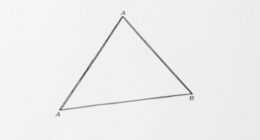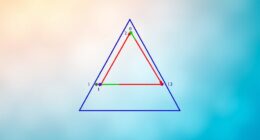Triangles are key shapes classified by sides—equilateral, isosceles, scalene—and by angles—acute, obtuse, right. You’ll learn their properties, like how angles and sides relate, and the triangle inequality theorem, which guarantees side lengths form a valid triangle. Congruence rules help you verify similarity, while concepts like medians, altitudes, and perpendiculars reveal internal symmetry. Understanding these basics sets the stage for exploring more complex theorems, so keep exploring to deepen your grasp.
Key Takeaways
- Triangles are classified by sides (equilateral, isosceles, scalene) and angles (acute, right, obtuse) for quick identification.
- Key triangle centers include centroid, incenter, circumcenter, and orthocenter, each with unique properties and significance.
- The Triangle Inequality Theorem states the sum of any two sides must exceed the third, ensuring valid triangle formation.
- Congruence criteria (SAS, ASA, SSS) determine when triangles are identical in shape and size, aiding in proofs and constructions.
- Coordinate geometry provides algebraic methods to analyze triangle properties, solve problems, and verify theorems visually.
Types of Triangles Based on Sides

Triangles can be classified into three main types based on their sides: equilateral, isosceles, and scalene. If a triangle has equilateral symmetry, all three sides are equal, creating a perfectly symmetrical shape. This type is unique because every angle is also equal, offering a clear example of symmetry. On the other hand, scalene triangles stand out for their scalene uniqueness; all three sides are different, and no two angles are alike. This makes scalene triangles more irregular, emphasizing their lack of symmetry. Each classification highlights different properties, helping you understand the diversity of triangle shapes. Recognizing these differences allows you to identify triangles quickly and understand their specific characteristics. Additionally, understanding the properties of electric bikes can enhance your knowledge of modern transportation options.
Types of Triangles Based on Angles

| Triangle Type | Angle Description |
|---|---|
| Acute | All angles less than 90° |
| Obtuse | One angle greater than 90° |
| Right | Exactly one 90° angle, with specific properties |
| Analyzing triangle types helps in understanding their properties and classifications.
Properties of Triangles
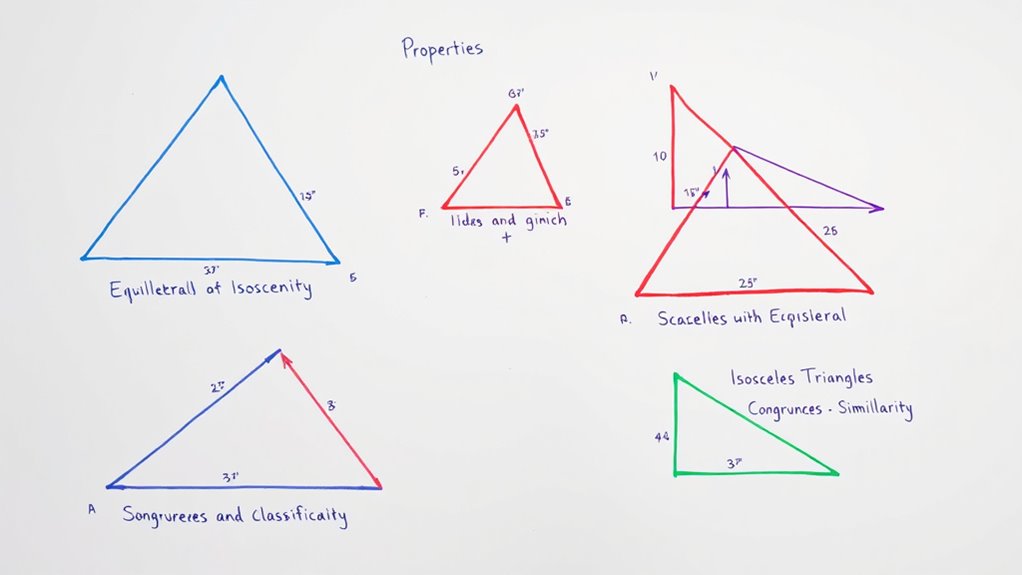
Understanding the properties of triangles helps you analyze their shapes and behaviors more effectively. One key property involves angle bisectors, which divide angles into equal parts and intersect at a point called the incenter, a type of triangle center. This incenter is equidistant from all sides, making it essential in inscribing circles within triangles. Other triangle centers include the centroid, where medians meet, and the circumcenter, where perpendicular bisectors intersect. Recognizing these properties allows you to identify important points within a triangle and understand how they relate to its angles and sides. These centers reveal symmetry, balance, and special relationships, providing a foundation for solving geometric problems and exploring more complex theorems. Additionally, understanding various properties of triangles can aid in Ford Tuning, where precise adjustments optimize vehicle performance based on geometric principles.
Triangle Inequality Theorem

The Triangle Inequality Theorem explains the rules for side lengths in a triangle. It states that the sum of any two sides must be greater than the third side. Understanding these constraints helps you determine if a set of lengths can form a valid triangle. Additionally, this theorem is fundamental in classifying triangles based on their side lengths and angles.
Side Length Constraints
To determine if three side lengths can form a triangle, you need to check the Triangle Inequality Theorem. This theorem states that the sum of any two side lengths must be greater than the third. These side length constraints ensure that the sides connect properly and form a closed shape. It’s important to contemplate triangle side ratios, as they help identify the type of triangle you’re working with. For example, if the sum of two sides equals the third, the sides form a degenerate triangle, which isn’t a true triangle. Additionally, understanding the side length constraints helps prevent invalid measurements that cannot produce a proper triangle. By applying these constraints, you can quickly verify whether your given side lengths satisfy the necessary conditions for triangle formation, ensuring your measurements are valid before proceeding with further analysis or construction.
Triangle Construction Rules
When constructing a triangle, the Triangle Inequality Theorem guides you to make certain that your side lengths can connect properly. It states that the sum of any two side lengths must be greater than the third side. This guarantees the sides can form a valid triangle. Once you confirm this, you can accurately draw angle bisectors to divide angles into equal parts, helping with precise construction. The triangle centroid, where the medians intersect, relies on correct side lengths and angles. If the side lengths satisfy the theorem, your constructed triangle will have a well-defined centroid and balanced angles. Additionally, understanding the impact of contrast ratio on image quality can help in accurately assessing the visual depth and clarity of your construction, ensuring precise and visually appealing results. Following these rules ensures your triangle is valid, and the properties like angle bisectors and centroid are accurately represented in your drawing.
Congruence of Triangles

Understanding when two triangles are congruent is essential in geometry because it allows you to determine if they have exactly the same size and shape. Congruent triangles can be mapped onto each other through geometric transformations like rotations, reflections, or translations, showcasing triangle symmetry. These transformations show that the triangles are identical in every way, with corresponding sides and angles equal. Recognizing congruence helps in solving problems involving missing parts or verifying constructions. The key criteria—such as Side-Angle-Side (SAS), Angle-Side-Angle (ASA), and others—allow you to establish congruence without measuring every side or angle. By understanding these principles, you can confidently identify when two triangles are congruent and apply this knowledge to more complex geometric proofs. Additionally, having a solid grasp of geometric transformations can deepen your understanding of how congruence relates to symmetry and shape preservation.
Pythagoras’ Theorem and Its Applications
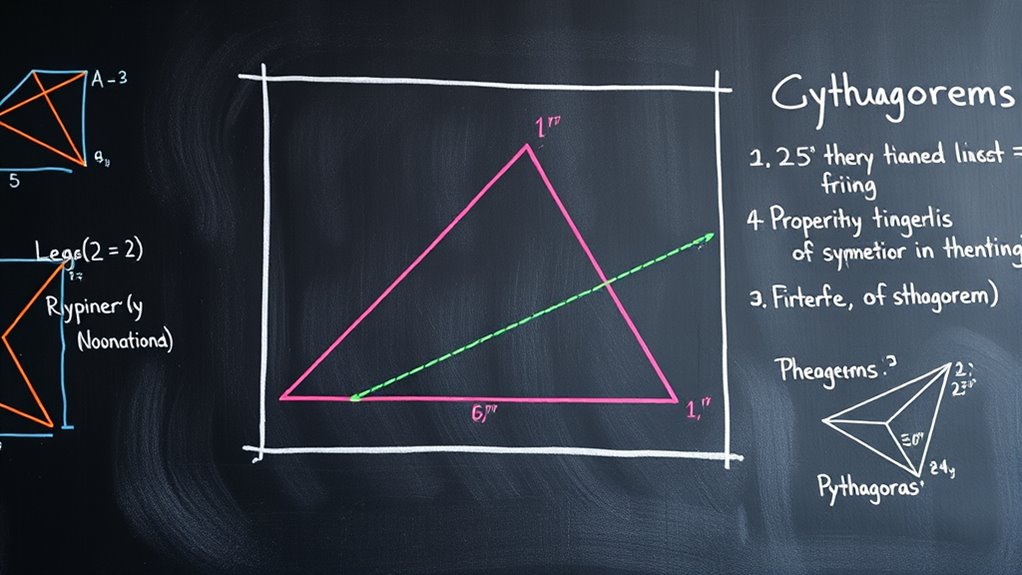
Have you ever wondered how to find the length of a side in a right triangle without measuring it directly? Pythagoras’ theorem makes this easy. It states that in a right-angled triangle, the square of the hypotenuse equals the sum of the squares of the other two sides. This principle is vital for right angled triangle calculations and has many Pythagoras’ theorem applications. You can use it to determine unknown lengths, check if a triangle is right-angled, or solve real-world problems like construction and navigation. By applying the theorem, you simplify complex measurements and guarantee accuracy. Mastering this concept helps you analyze and solve many geometric problems efficiently, making it a fundamental tool in geometry and beyond. Additionally, understanding the properties of triangles can enhance your grasp of triangle classifications and their various theorems.
Themed Properties: Medians, Altitudes, and Perpendiculars
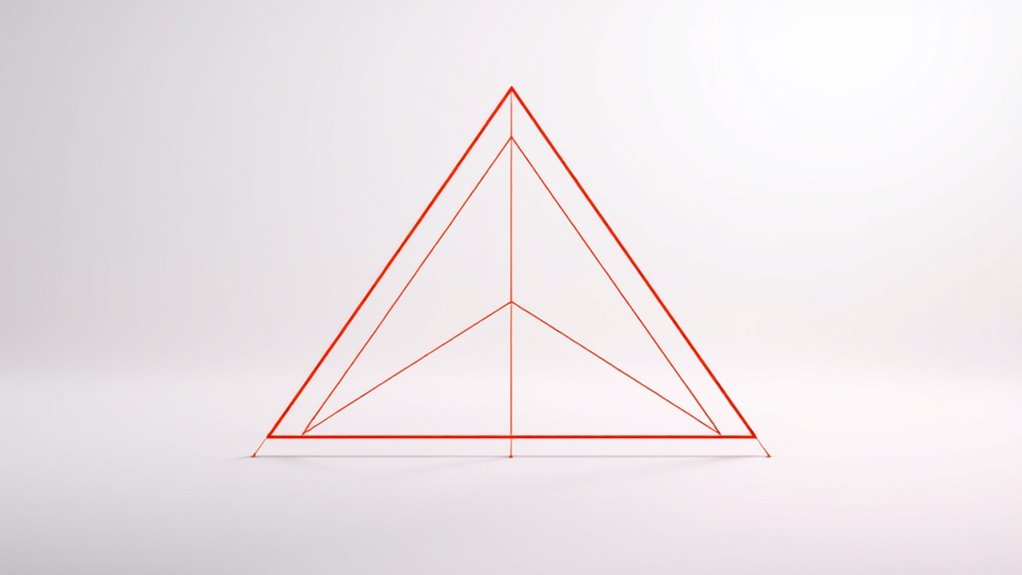
Building on the principles of right triangles, the properties of medians, altitudes, and perpendiculars reveal fascinating insights into a triangle’s structure. Medians connect each vertex to the midpoint of the opposite side, intersecting at the centroid, which balances the triangle. Altitudes drop from a vertex perpendicular to the opposite side, meeting at the orthocenter, which can lie inside or outside the triangle. Perpendiculars help in constructing right angles and in proving key properties. The table below summarizes relationships among these elements:
| Property | Key Point | Notable Location |
|---|---|---|
| Median | Connects vertex to midpoint | Centroid |
| Altitude | Perpendicular from vertex | Orthocenter |
| Perpendicular | Forms right angles | Used in constructions |
| Intersection | Median, altitude, perpendiculars | Inside or outside triangle |
Coordinate Geometry and Triangles
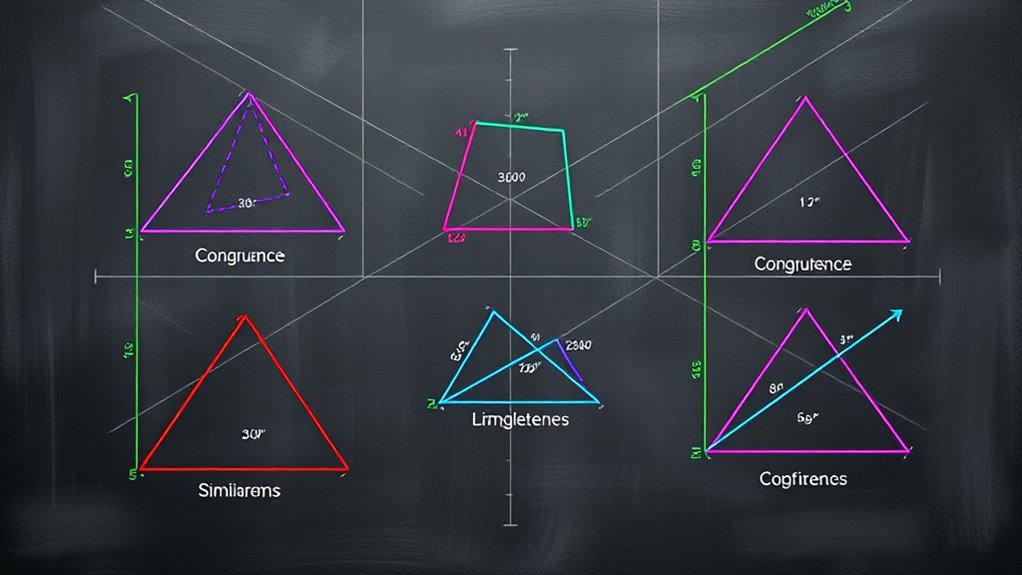
How can coordinate geometry help you analyze and solve problems involving triangles? By plotting points on a coordinate plane, you can apply algebraic formulas to find side lengths, slopes, and angles. This approach allows you to prove properties of triangles using coordinate proofs, making your solutions more precise. You can also explore circle theorems, such as angles subtended by the same arc or cyclic quadrilaterals, within coordinate systems. Using equations of circles and lines, you can verify whether a point lies inside, on, or outside a circle, which is useful for solving problems involving inscribed or circumscribed triangles. Overall, coordinate geometry provides a visual and algebraic framework that simplifies complex triangle problems and enhances your understanding of their properties. Additionally, it enables you to analyze the properties of polygons within the same coordinate plane, broadening your geometric problem-solving toolkit.
Frequently Asked Questions
How Do Triangles Relate to Real-World Architectural Designs?
You see, triangles play a vital role in real-world architectural designs because they provide structural stability. When you incorporate triangles into buildings, they help evenly distribute weight and resist deformation. Plus, they add aesthetic appeal, giving structures a sleek, balanced look. So, whether in bridges, roofs, or frameworks, triangles enhance both the strength and visual attractiveness of architectural projects, making them essential in design and construction.
Can Triangles Be Used to Calculate Areas of Irregular Shapes?
Thinking of area calculation like fitting puzzle pieces together, you might wonder if triangles help with irregular shapes. The answer is yes; you can break down irregular shapes into triangles, then calculate each triangle’s area. This method simplifies complex shapes, making area calculation easier and more accurate. By dividing irregular shapes into triangles, you get a practical way to find the total area efficiently and precisely.
What Is the Significance of the Centroid in a Triangle?
The centroid significance lies in its role as the triangle’s balance point. It’s where the medians intersect, dividing the triangle into six smaller triangles of equal area. You can use this point to understand how the shape balances and how to find the center of mass. Recognizing the centroid helps in designing stable structures and solving geometric problems, making it a vital concept in understanding triangle properties and their applications.
How Do Triangles Help in Navigation and Triangulation?
Triangles play a key role in navigation and triangulation techniques by helping you determine precise locations. When using triangulation, you measure angles from known points to pinpoint your position. This method enhances navigation accuracy, especially in mapping and surveying. You rely on the inherent properties of triangles to create accurate spatial relationships, making it easier to find your way or map out areas effectively.
Are There Triangles With More Than Three Sides?
You might wonder if there are triangles with more than three sides. The answer is no, since triangles are defined as three-sided figures. For figures with more sides, you look at polygon classifications, which include quadrilaterals, pentagons, and others. Triangles are unique because they are the simplest polygons, with just three sides, and serve as building blocks for understanding more complex shapes.
Conclusion
Now that you’ve navigated the nifty notions of triangles, you’re never alone in understanding their unique, universal, and unparalleled properties. With wisdom woven from theorems, theorems, and truths, you’re well-equipped to explore, analyze, and apply triangles in every angle of your mathematical journey. Remember, mastering the marvels of triangles transforms complex concepts into clear, enthralling comprehension—making your mathematical mastery both memorable and meaningful.







